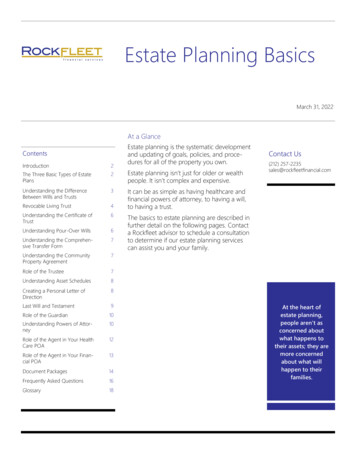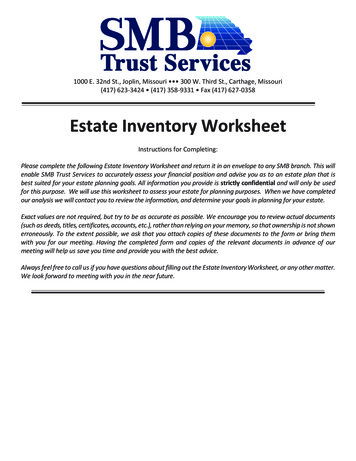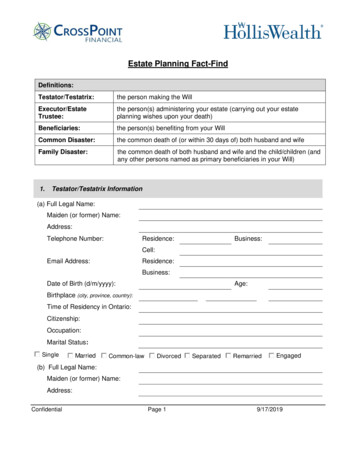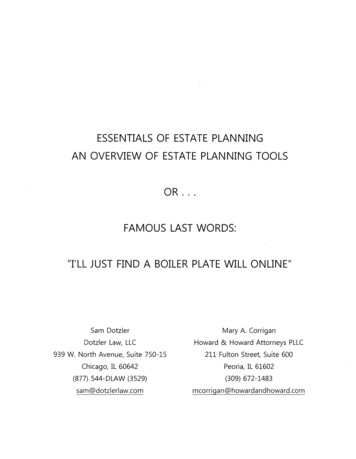
Transcription
Estate Planning BasicsEstate Planning BasicsMarch 31, 2022At a GlanceContentsEstate planning is the systematic developmentand updating of goals, policies, and procedures for all of the property you own.Introduction2The Three Basic Types of EstatePlans2Estate planning isn’t just for older or wealthpeople. It isn’t complex and expensive.Understanding the DifferenceBetween Wills and Trusts3Revocable Living Trust4It can be as simple as having healthcare andfinancial powers of attorney, to having a will,to having a trust.Understanding the Certificate ofTrust6Understanding Pour-Over Wills6Understanding the Comprehensive Transfer Form7Understanding the CommunityProperty Agreement7Role of the Trustee7Understanding Asset Schedules8Creating a Personal Letter ofDirection8Last Will and Testament9Role of the Guardian10Understanding Powers of Attorney10Role of the Agent in Your HealthCare POA12Role of the Agent in Your Financial POA13Document Packages14Frequently Asked Questions16Glossary18Contact Us(212) 257-2235sales@rockfleetfinancial.comThe basics to estate planning are described infurther detail on the following pages. Contacta Rockfleet advisor to schedule a consultationto determine if our estate planning servicescan assist you and your family.At the heart ofestate planning,people aren't asconcerned aboutwhat happens totheir assets; they aremore concernedabout what willhappen to theirfamilies.
Page 2Proper estateplanning allows youto:Preserve your estatefor your loved onesand stay in controlfor as long aspossibleDirect who is goingto receive yourestate, includingwhen and how muchyour beneficiarieswill receiveIdentify whooversees yourfinances if you’resick or disabledIdentify who makesmedical decisionsfor you if you’re sickor disabledEnsure your wishesare fulfilled afterdeathMinimize and/oreliminates the costlyand time consumingprobate processEstablishguardianship forminor childrenProvide peace ofmind and reducesstress on your familyAvoid unnecessarytaxes, fees andcommissionsEstate Planning BasicsI.IntroductionYour estate consists of all the property you own, whatever it is worth, and wherever itis located. Estate planning is the systematic development and updating of goals,policies, and procedures for all of the property you own. However, estate planningisn't truly about things; it's about people. At the heart of estate planning, peoplearen't as concerned about what happens to their assets, they are more concernedabout what will happen to their families.Estate planning isn’t just for older or wealth people. It isn’t complex and expensive.Our process involves a Rockfleet advisor asking you simple questions to which youalready know the answers. From there, a licensed attorney from our network helpscreate high quality documents that ensure that your wishes are accurately carriedout. Your Rockfleet advisor can then assist you in funding your trust, if a trust-basedplan is chosen.II.The Three Basic Types of Estate PlansEven if you do nothing, you have an estate plan, just not a very good one. Accordingto one author, over half of the adult population as opted for this approach and donenothing. By not creating your own plan you simply force the legal system todistribute your wealth. Every state has statutes on how to distribute property when aperson dies “intestate.” This is the technical term for dying without a will.The question then, is not whether you will have an estate plan, but whether you willhave a cost effective estate plan of your own selection, or a costly estate planimposed upon you by law.So what kind of estate planning documents should you put into place?An individual’s wishes are most frequently drafted in the form of a will. You can alsooutline your desires in a trust. During the interview process, the first few questions inthe online interview determine which documents are appropriate given your uniquecircumstances. You will fall into one of three general categories - estate plan builtaround a revocable living trust, estate plan built around a simple will, or an estateplan built around Powers of Attorney.Trust-BasedPlanWill-BasedPlanPowers of Attorney-BasedPlanWhen you own realestateWhen you do not own realproperty, but have minorchildrenWhen you do not ownproperty, have no minorchildren, and little or noIn addition to their core document, every will or trust plan will include: financialpower of attorney (“POA”), healthcare power of attorney, healthcare directives, and aHIPAA release form. The first few questions in the online interview, the attorneyassigned to your estate plan determines the type of documents that are required.Rockfleet Financial Services, Inc.
Estate Planning BasicsPage 3III. Understanding the Difference Between Wills andTrustsEveryone has heard the terms Wills and Trusts; however, many people don'tunderstand the difference between the two. Both are useful estate planning toolsthat serve different purposes.A last Will and testament is a legal document that outlines the wishes for theadministration and division of an estate after passing.A Trust is a fiduciary arrangement that allows a third party, or trustee, to hold assetson behalf of a beneficiary or beneficiaries. It is a legal document that is traditionallyused for avoiding probate and minimizing estate taxes. Like a Will, it outlines thewishes for the administration and division of an estate plan.With our process, you don't have make the decision on your own. Your estateplanning session starts with a series of questions specifically designed by ourcontracted attorneys. Your answers to these questions gives the attorney theinformation needed to make a document recommendation.A.ProbateProbate is the process of changing the title on assets when someone passes away.Assets that are owned in a deceased person’s individual name and for which there isno named beneficiary, are no longer accessible once the owner of the asset hasdied. In order for family members to gain access to accounts or other assets in thedeceased’s individual name, they must file a petition with the probate court and waitfor the court to approve the Will and appoint the Personal Representative. This canbe a long and costly process during which bills cannot be paid and assets cannot bemanaged. A Trust is an excellent tool to avoid probate because assets that areowned in the name of a Trust are immediately accessible to the trust-maker’sdesignated successor.B.Creditor ProtectionMany people worry that the inheritance they leave to their children will be lost totheir children’s creditors such as a divorcing spouse, unpaid credit card bills, abankruptcy, a business loss, or a lawsuit. Sadly, this is often the case when assets aredistributed to beneficiaries via a Will. A Trust allows the maker to safeguard aninheritance from the reach of the beneficiaries’ creditors by keeping the assets out ofthe name of the beneficiary. Ownership of the assets remains in the Trust. Thebeneficiary will have access to the assets in accordance with the directions you leavein your Trust. You may also allow your beneficiary to serve as Trustee, allowing thebeneficiary to manage her own inheritance. By leaving assets to your beneficiariesvia a Trust rather than outright via your Will, you can ensure that the assets youworked so hard for will be available to your children and future generations.C.Special Needs ProtectionIf you have a child, grandchild or other beneficiary with disabilities, then a Trust is amust. If you leave assets to a person who receives needs-based governmentalbenefits via your Will, it will place your beneficiary in the difficult position of eitherRockfleet Financial Services, Inc.Trusts provideadvantages willscannot:Avoid probateProvide creditorprotection for theinheritance left tobeneficiariesProtectgovernmentalbenefits for a personwith disabilitiesReduce estate taxesAdminister assetsfor minorbeneficiaries withoutcourt intervention
Page 4A revocable livingtrust can providemany benefits:Added control overyour assetsAvoid the public,costly and timeconsuming courtprocesses at death(probate) andincapacity(conservatorship orguardianship)Provide for yourspouse withoutdisinheriting yourchildrenSave estate taxesProtect inheritancesfor children andgrandchildren fromthe courts, creditors,spouses, divorceproceedings, andirresponsiblespendingEstate Planning Basicslosing those benefits, or transferring the inheritance into a Trust of which the statemust be the beneficiary at the beneficiary’s death. Unless the inheritance you areleaving is so significant that the monetary and medical benefits available to theperson through programs such as Social Security and Medicaid are no longerimportant, then making sure that those governmental benefits continue to beavailable is vital. Leaving assets to a person with disabilities via a Trust is the bestway to ensure those governmental benefits are preserved and that the inheritanceyou leave will be available to pay for expenses that are not covered by thesegovernmental benefits.D.Estate TaxesFor married couples, including same-sex married couples, the use of a Trust in theirestate plan can significantly reduce or even eliminate both federal and state estatetaxes assessed against their estates.E.Assets for Minor ChildrenLeaving money directly to a minor creates an administrative nightmare because thelaw provides that a minor does not have the legal capacity to receive assets. Theparent of the minor also does not have the ability to act as the child’s legalrepresentative until the court says so. As such, if you die with a Will that leavesmoney to minor beneficiaries, the court will need to appoint a Conservator to receivethat inheritance for your children. The Conservator will be required to reportannually to the court and the court will appoint an overseer (guardian ad litem) tomake sure the Conservator is doing his or her job for your minor beneficiaries. Thismeans huge costs and long delays in administering funds for minors. It also meansthat when the minor turns 18, he or she will be entitled to receive all of those assetsand will be free to do with them as he or she wishes (think fast cars, spring break,and lots of shopping). Creating a Trust to receive assets passing to a minor, or evento a young adult beneficiary, is the best way to ensure that the court is not involvedin the process, that the person you want to manage assets for the beneficiary is ableto do so, and that the beneficiary can use the assets only for purposes you decideare important and/or at ages that you dictate.IV.Revocable Living TrustA.BenefitsA revocable living trust can save you time and money, as well as added control overyour assets. A living trust can avoid the public, costly and time-consuming courtprocesses at death (probate) and incapacity (conservatorship or guardianship). It canlet you provide for your spouse without disinheriting your children, which can beimportant in second marriages. It can save estate taxes. And it can protectinheritances for children and grandchildren from the courts, creditors, spouses,divorce proceedings, and irresponsible spending.B.What is a Revocable Living Trust?A living trust is a legal document that, just like a will, contains your instructions forwhat you want to happen to your assets when you die. But, unlike a will, a living trustRockfleet Financial Services, Inc.
Estate Planning BasicsPage 5can avoid probate at death, control all of your assets, and prevent the court fromcontrolling your assets if you become incapacitated.C.What is Probate?Probate is the legal process through which the court sees that, when you die, yourdebts are paid and your assets are distributed according to your will. If you don'thave a valid will, your assets are distributed according to state law.D.What Are the Negatives of Probate?It can be expensive. Legal fees, executor fees and other costs must be paid beforeyour assets can be fully distributed to your heirs. If you own property in other states,your family could face multiple probates, each one according to the laws in thatstate. These costs can vary widely; it would be a good idea to find out what they arenow.It takes time, usually nine months to two years, but often longer. During part of thistime, assets are usually frozen so an accurate inventory can be taken. Nothing canbe distributed or sold without court and/or executor approval. If your family needsmoney to live on, they must request a living allowance, which may be denied.With probate, your family has loses privacy. Probate is a public process, so any"interested party" can see what you owned, whom you owed, who will receive yourassets and when they will receive them. The process invites disgruntled heirs tocontest your will and can expose your family to unscrupulous solicitors.Your family has no control. The probate process determines how much it will cost,how long it will take, and what information is made public.E.The ProcessThere are three participants to every trust:GrantorTrusteeBeneficiaryThe individual whocreates the trustThe individual whomanages the trust andThe individual who receivesthe benefit of all the assetsAny legal arrangement that has these three participants — a creator, a manager anda beneficiary — is a trust.When you create your trust using our platform, you are all three — you are thegrantor, the trustee and the beneficiary. You create your trust and name yourself tomanage your trust for your own personal benefit. One way to look at your trustdocument is simply as the instructions you are giving to yourself.Once your trust document is created, you must formally change title to all yourassets. Your trust can only control the assets that it “owns.” You transfer ownershipfrom yourself as an individual, to yourself as trustee of your trust. This process oftransferring ownership is known as “funding” your trust.Rockfleet Financial Services, Inc.There are severalreasons to avoidprobate:Avoid legal,executor, and otherfeesAvoid multipleprobates if you ownproperty in multiplestatesAvoid assets beingfrozen while aninventory is takenMaintain family’sprivacy
Page 6For the trust toavoid probate it isessential that allyour assets beplaced in (i.e.,funded) your trust.The only exceptionis Qualified PlanAssets - IRA, 401k,403b plans.For income taxpurposes, it isprudent that theseassets be owned byyou individually, notas trustee of yourtrust.The beneficiarydesignation willensure these assetsavoid probate.Estate Planning BasicsFrom a legal standpoint, once you transfer your assets into your trust, you no longerhold title to anything; since your assets are inside the trust. However, even thoughyou have relinquished ownership or your assets you still control those same assets.Your control of those assets is the same as before you put them into your trust. Astrustee of your trust, you still have power to buy, sell, transfer, borrow, and dowhatever you wish with “your” assets.In your trust, you name a successor trustee. This is the person who will manage yourtrust, and the assets owned by your trust, upon your death or incompetence. At yourdeath, you do not own any assets, (as you have transferred all your assets to yourliving trust), so you have no assets subject to probate, resulting in savings of timeand money. At your death, the administration of your affairs simply passes to yoursuccessor trustee without any public fanfare or governmental oversight.Your successor trustee must be of legal age. Your successor trustee serves in afiduciary capacity. This means that, in all matters relating to the trust and your assets,the successor trustee must act with prudence and strictly in accordance with allinstructions outlined in your trust.V.Understanding the Certification of TrustThe certification of trust is a short one page document that outlines the key issuesinvolved in your trust. It identifies the trust name, the date the trust was signed andnotarized, and confirms that the trust is indeed a legally binding document.The certification also identifies the grantors and trustees and confirms that thetrustee has the power to act on behalf of the trust. The specific powers of the trusteeare reaffirmed in full and often the “Powers of Trustee” section of the trust will beattached in full.Nothing about your beneficiaries or details of regarding the distribution of assets isincluded in the certification of trust.The certification is primarily used to transfer title of assets into the trust.VI.Understanding Pour-Over WillsA pour-over will is only used when your estate plan is based around a living trust. Ifyour plan included a living trust, it will also include a pour-over will.Your living trust is the only beneficiary named in your pour-over will. Your actualbeneficiaries and the details about how your assets are to be distributed are outlinedin your living trust. Your pour-over will acts as a “safety net” to ensure that any assetsnot funded into your living trust while you were alive are transferred to your trust atyour death.Like a traditional will, a pour-over will is subject to probate process. As such you donot want to rely on your pour-over will to distribute your wealth. Your pour-over willis precautionary tool to make sure your assets are distributed as you intend.Just as with a simple will based portfolio, guardians of your minor children arenamed in your pour-over will. The same execution procedures exist for pour-overRockfleet Financial Services, Inc.
Estate Planning BasicsPage 7wills as for normal wills — two witnesses, over the age of 18 who are not namedbeneficiaries or otherwise potential heirs to your estate.VII. Understanding the Comprehensive Transfer FormYour living trust can only control the assets that it owns. Transferring ownership ofyour assets to your trust is done on an asset-by-asset basis, one asset at a time. Theprocess is not difficult but it does take time and require close attention to detail.The comprehensive transfer form transfers all assets that do not have a formal title.Things such as personal property, family heirlooms, collections, etc. are specificallyreferred to and covered by the comprehensive transfer form.With every trust document, the attorney will create a pour-over will. The primarypurpose of the pour-over will is to transfer title to assets to the living trust upondeath, if assets were not transferred prior to death. Relying on pour-over will to fundthe trust requires probate, however.Like the pour-over will, another purpose of the comprehensive transfer form is todocument your intent that all assets you owned when you created your trust were tobe transferred to your living trust.There have been instances where the courts have permitted the use of acomprehensive transfer form in lieu of the pour-over will for the purpose of fundinga trust. The comprehensive transfer form is a precautionary document that providesthe basis for request the court to waive probate, if assets were not properly fundedduring your lifetime.You should not rely on the comprehensive transfer form to fund your trust. The onlyacceptable way to transfer title is asset-by-asset.VIII. Understanding the Community Property AgreementThere are nine community property states: Arizona, California, Idaho, Louisiana,Nevada, New Mexico, Texas, Washington and Wisconsin. Alaska is an opt-incommunity property state that gives both parties the option to make their propertycommunity property.Married individuals, in any of these states, can elect to own their jointly held propertyas community property. Upon death, holding title to your assets as communityproperty provides significant income tax advantages for the surviving spouse. Toensure that the surviving spouse receives these income tax advantages, a communityproperty agreement is created for all married individuals who reside in communityproperty states.Note: Rockfleet is currently providing estate planning services in the State of NewYork only.IX.Role of the TrusteeThe individual you name as trustee stands in a fiduciary role with respect to thebeneficiaries of the trust, both the current beneficiaries and any remaindermenRockfleet Financial Services, Inc.Examples of assetsto fund yourrevocable livingtrust include:AircraftAnnuityAutomobilesBoatBrokerage AccountsBurial PlotCertificate ofDepositChecking AccountClosely Held Stock(Sub-S or Inc.)Employee BenefitsGeneral PartnershipInterestGovernmentSecurities in YourPersonalPossessionIndividualRetirement Account(IRA)JudgmentLife Insurance PolicyLimited LiabilityCompany (LLC)Limited PartnershipInterest
Page 8Estate Planning BasicsExamples of assetsto fund yourrevocable livingtrust include:Mineral RightsMotor HomeMutual FundAccountsPatent or TrademarkPension and ProfitSharing PlanPersonal PropertyProfessionalCorporationPromissory NoteReal EstateRecreational VehicleRoyaltiesSafe Deposit BoxSavings AccountSole ProprietorshipStock CertificatesTimeshareUniform Transfers toMinors Account(UTMA)Uniform Gift toMinors Account(UGMA)401(k) RetirementPlannamed to receive trust assets upon the death of those entitled to income or principalnow. As a fiduciary, your trustee is held to a very high standard, meaning he or shemust pay even more attention to the trust investments and disbursements than forhis or her own accounts.As grantor, you should make that your trustee is familiar with the trust and itsprovisions. Your trustee should know who else is named as trustees, who thesuccessor trustees are, the order in which they are slated to act, and if he or she willbe acting alone or with someone else. In addition, your trustee should know wheretrust assets, insurance policies (medical, life, disability, long term care, etc.) and otherimportant papers are located.Using the “People” tab in the online platform, you can share all the necessarydocuments information with your successor trustee with a simple click of a mouse.Specifically, the trustee acts as the legal owner of trust assets and is responsible forhandling any of the assets held in trust, tax filings for the trust, and distributing theassets according to the terms of the trust.X.Understanding Asset SchedulesThe asset schedules are located at the very end of the trust. There is one assetschedule for a single person trust. There are three assets schedules in each marriedtrust — one asset schedule for the separate property for each spouse and oneschedule for all jointly owned assets.Listing an asset on an asset schedule does NOT fund that asset into the trust. Inorder for an asset to be legally owned by the trust the trust must be formallyidentified as the owner of record with the institution that controls or holds title to theasset.So what is the purpose of the asset schedule? The asset schedule, when kept current,is a great recap for your successor trustee of the assets to be included in your estate.It is a starting point identifying the assets he or she needs to confirm exist. The assetschedules are intended to be updated no less than annually.Asset schedules can be modified as often as needed without having to make aformal amendment to the trust document. The details needed to create detailedasset schedules are entered under an entirely separate tab entitled “Assets” in theonline portal. You should make changes to the asset listing whenever you buy or sellan asset.To reinforce the need to go asset-by-asset and formally add the trust as the owner,all asset schedules show that the trust is funded with “ 10 transferred from thegrantor to the trustee.”XI.Creating a Personal Letter of DirectionA personal Letter of Direction is a letter you write to your beneficiaries, heirs andthose charged with finalizing your affairs upon your death. Your letter of directiondoes not have to meet any kind of legal format or other formal requirements. It canbe handwritten or printed out on plain paper.Rockfleet Financial Services, Inc.
Estate Planning BasicsPage 9Unlike your will or living trust, your personal letter of direction doesn't have any legalauthority, but provides you a forum to express the thoughts that you want to passon to your loved ones, executor and successor trustee.Your personal letter of direction can also outline more personal desires, includingsuch details as where you want to be buried and the kind of funeral that you want.You can specify location, funeral home or even what type of flowers you would like,or whether you would like your ashes to be displayed at the ceremony or even yourown obituary.Your personal letter is the best place to outline the details of how you want yourpersonal property distributed. You can use the letter to voice other personal requeststhat may be inappropriate for a will or trust, such as a general sentiment about howyou would like your heirs to use their inherited assets.The estate planningdocuments createdusing our platformdirect yoursuccessor trusteeand executor torefer to, and followas much as possible,any instructions theyfind in your letter ofdirection.Finally, you can elaborate on the medical conditions under which you would like tobe taken off life support in more detail than is permitted in healthcare or medicaldirectives. You can use your letter of direction to pass down your values, beliefs andideals to your loved ones.XII.Last Will and TestamentThe stark reality is, upon your death, all your possessions have to go somewhere.Your last will and testament provides your instructions about where your things aresupposed to go. Your will is like a letter to the court, and not to your heirs, becauseevery will must be presented to the court before it is valid. The process ofadministering your will is known as probate.The person designated in your will to administer your affairs and make sure all yourthings get to where and whom you directed is known as your executor or executrix.The probate court oversees the process to ensure the executor does everything yourequested. On average, the probate process takes about 7 to 9 months anddepending on complexity of your affairs costs between 3% to 8% of your total assets.In addition, probate is a public proceeding, and as such, the details of your willbecome part of the public record.To cut costs and time delays associated with probate, every state has a simplifiedprobate process for individuals without real property and whose wealth is less than aspecified amount, but on average it is approximately 50,000. Using a simplifiedprobate process makes using a will a viable option for individuals who do not ownreal property and have limited wealth.If your circumstances are such that a will-based plan, combined with properly namedbeneficiary designations, will not trigger unnecessary costs, our planning process willrecommend that your estate plan be built around the use of a simple will. Wills areindividual documents, so if you're married, your plan will contain one will for eachspouse.In order for your will to be valid, it must be signed and dated in front of at least twowitnesses. Witnesses must be at least 18 years of age and not named as beneficiariesor be potential heirs.Rockfleet Financial Services, Inc.Not all assets aresubject to probate.Assets with namedbeneficiaries, suchas life insurance,IRAs, 401Ks, jointlyheld assets withrights ofsurvivorship andfinancial accountswith POD (pay ondeath) designationsall pass outside ofthe will directly tothe namedbeneficiary and arenot considered partof the probateprocess.
Page 10Estate Planning BasicsFinally, and of extreme importance, in addition to outlining how your assets are to bedistributed, guardians for minor children are named in the will.The role of theguardian willessentially be therole you have nowas a parent — caringfor your children,acting in their bestinterests, andproviding for ally, andculturally.XIII. Role of the GuardianWhen considering who could take custody of your children, there are a number ofquestions to address: Are they willing to serve as guardian of your children? Do they have the maturity and stability to parent your children? Do they have the time and energy to take on the task of raising your children? Is their age or health a consideration? Do they know and love (or at least care about) your children? Do your children like them? Will they love your children and provide the support, comfort and nurture thatyour children will need? Will they make it possible for your children to visit their grandparents or otherrelatives or close family friends? How far away do they live? Do they have room for your children, or will they need extra funds to allow themto add on or buy a larger house? Will they need to buy a larger vehicle? Are their values and financial lifestyle comparable to yours? If your children are homeschooled, how will this be handled? Will one parent have to quit work in order to take care of your children? Do they share your religious beliefs and practices?XIV. Understanding Powers of AttorneyPowers of Attorney are essential documents for every adult. Irrespective of wealth ormarital or family status, every individual 18 years of age or older should execute botha financial and healthcare power of attorney.If something happens, rendering you incapable of making financial and medicaldecisions for yourself, without a valid power of attorney, your loved ones will berequired to go to court and have a judge officially name a conservator to makethose decisions on your behalf. This process is both time consuming and costly.More importantly, it can be avoided altogether by executing two simple documents:a financial power of attorney and a healthcare power of attorney. Upon death, yourpowers of attorney are null and void.Rockfleet Financial Services, Inc.
Estate Planning BasicsA.Page 11Financial Power of AttorneyA Financial Power of Attorney empowers someone to make financial decisions foryou in the event you are incapacitated or otherwise incapable of making them for
III. Understanding the Difference Between Wills and Trusts Everyone has heard the terms Wills and Trusts; however, many people don't understand the difference between the two. Both are useful estate planning tools that serve different purposes. A last Will and testament is a legal document that outlines the wishes for the










